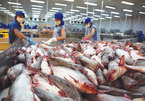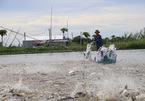 |
|
Tra fish being processed for export at Hung Ca Ltd in Dong Thap Province.
|
“We have been focused on tra fish export for the longest time. Only until recently when we have had to deal with difficult trade barriers and tumbling price that we started to look back and attempted to bring the fish to the domestic market,” said Pham Minh Thien, director-general of seafood processor and exporter Co May Imexco Jsc in the Mekong province of Dong Thap.
Thien said bringing the fish to domestic consumers is both a responsibility for Vietnamese fish farmers and an opportunity for the industry to become sustainable in the future.
According to the Vietnam Association of Seafood Exporters and Producers (VASEP), tra fish export during 2019 has fallen to just over US$2 billion, an 11.7 per cent decrease compared to the previous year.
Among Vietnamese tra fish export markets, the US, traditionally one of the largest buyers, has seen the biggest fall in demand. Tra fish export to the US in 2019 reached just over $280 million, a dismal figure compared to $560 million just a year before, with price dropped by 30-35 per cent since 2018. In addition, bumper harvests in the last two years have resulted in a surplus in supply, which drove tra fish price down in recent months.
By the end of 2019, the US accounted for just 14 per cent of Viet Nam’s total tra fish export, falling far behind China (32 per cent). Furthermore, the situation is likely to get worse as anti-dumping tariff remains high making it difficult for the Vietnamese fish to enter to the US market, said Nguyen Hoai Nam, VASEP deputy secretary-general.
Nam said there is still a large untapped potential for tra fish right on home ground.
Speaking at an event to introduce dishes made from tra fish to consumers in HCM City, deputy director-general of Saigon Food Le Thi Thanh Lam said the quality of tra fish is beyond question and firms should find ways to bring the product to the domestic market.
While tra fish have proven its popularity and met with strict standards in foreign markets, Vietnamese consumers have yet warmed up to the fish due to a misconception that industrial style fish farming produced less-than-desirable quality and may be unsafe to consume.
Industry experts, however, have pointed out that strict regulations and rigorously enforced safety procedures that shelter the fish from pollution sources, in fact, ensure that the fish is much safer to consume even compared against fish found in the natural environment.
In 2019, Vietnamesetra fish has been certified by the US Department of Agriculture to have met all US safety standards. — VNS

Catfish exports fall, VN farmers and exporters suffer
Vietnam’s catfish exports have seen a sharp decline because of trade barriers and price fluctuations in the world market.

Vietnam’s catfish industry loses clout, suffers lower prices in 2019
A series of problems are affecting Vietnam’s catfish industry, including a sharp fall in catfish material price and decrease in breeder quality. The industry has lost its monopoly. On the world market.
 As tra fish export has been on the decline in recent years due to a rise in trade protectionism in large traditional markets such as the US, Vietnamese firms are looking to bring the fish back home.
As tra fish export has been on the decline in recent years due to a rise in trade protectionism in large traditional markets such as the US, Vietnamese firms are looking to bring the fish back home.